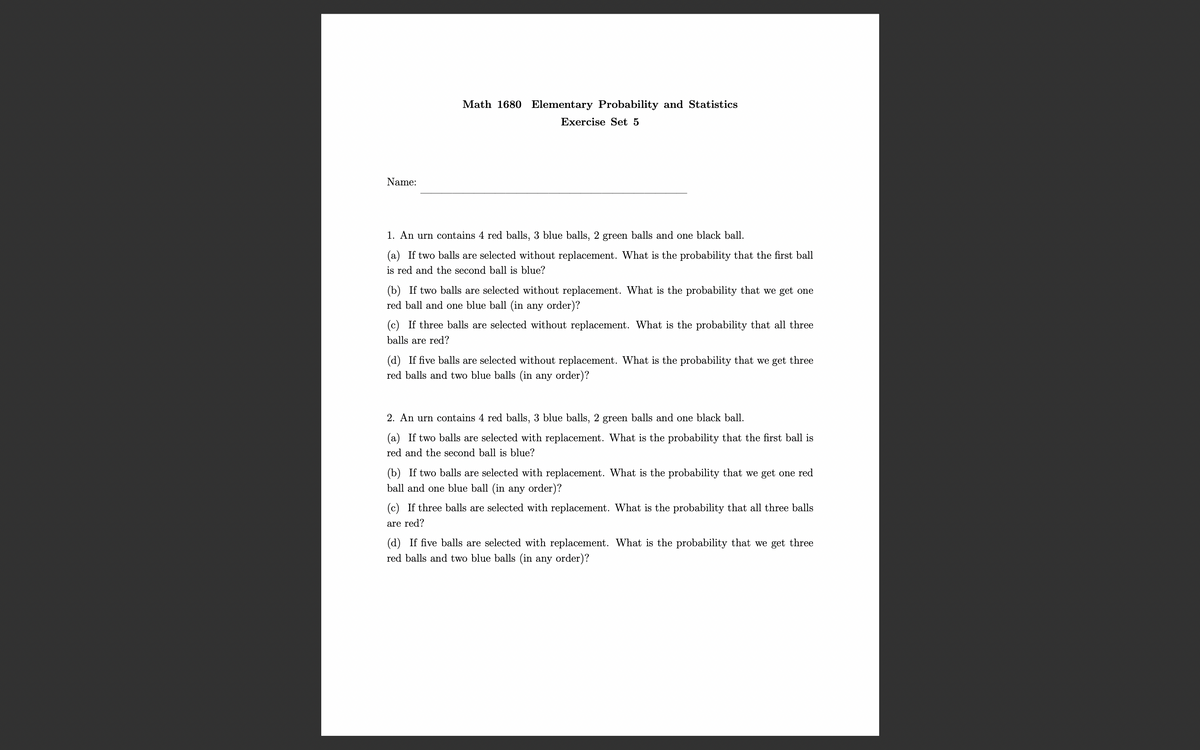(d) If five balls are selected without replacement. What is the probability that we get three red balls and two blue balls (in any order)?
(d) If five balls are selected without replacement. What is the probability that we get three red balls and two blue balls (in any order)?
Holt Mcdougal Larson Pre-algebra: Student Edition 2012
1st Edition
ISBN:9780547587776
Author:HOLT MCDOUGAL
Publisher:HOLT MCDOUGAL
Chapter11: Data Analysis And Probability
Section11.9: Independent And Dependent Events
Problem 11E
Related questions
Topic Video
Question
Can you answer question 1- Section D only?
and then question 2-A-B only ?? Thank you

Transcribed Image Text:Math 1680 Elementary Probability and Statistics
Exercise Set 5
Name:
1. An urn contains 4 red balls, 3 blue balls, 2 green balls and one black ball.
(a) If two balls are selected without replacement. What is the probability that the first ball
is red and the second ball is blue?
(b) If two balls are selected without replacement. What is the probability that we get one
red ball and one blue ball (in any order)?
(c) If three balls are selected without replacement. What is the probability that all three
balls are red?
(d) If five balls are selected without replacement. What is the probability that we get three
red balls and two blue balls (in any order)?
2. An urn contains 4 red balls, 3 blue balls, 2 green balls and one black ball.
(a) If two balls are selected with replacement. What is the probability that the first ball is
red and the second ball is blue?
(b) If two balls are selected with replacement. What is the probability that we get one red
ball and one blue ball (in any order)?
(c) If three balls are selected with replacement. What is the probability that all three balls
are red?
(d) If five balls are selected with replacement. What is the probability that we get three
red balls and two blue balls (in any order)?
Expert Solution
This question has been solved!
Explore an expertly crafted, step-by-step solution for a thorough understanding of key concepts.
This is a popular solution!
Trending now
This is a popular solution!
Step by step
Solved in 2 steps

Knowledge Booster
Learn more about
Need a deep-dive on the concept behind this application? Look no further. Learn more about this topic, probability and related others by exploring similar questions and additional content below.Recommended textbooks for you

Holt Mcdougal Larson Pre-algebra: Student Edition…
Algebra
ISBN:
9780547587776
Author:
HOLT MCDOUGAL
Publisher:
HOLT MCDOUGAL

Algebra and Trigonometry (MindTap Course List)
Algebra
ISBN:
9781305071742
Author:
James Stewart, Lothar Redlin, Saleem Watson
Publisher:
Cengage Learning

Holt Mcdougal Larson Pre-algebra: Student Edition…
Algebra
ISBN:
9780547587776
Author:
HOLT MCDOUGAL
Publisher:
HOLT MCDOUGAL

Algebra and Trigonometry (MindTap Course List)
Algebra
ISBN:
9781305071742
Author:
James Stewart, Lothar Redlin, Saleem Watson
Publisher:
Cengage Learning